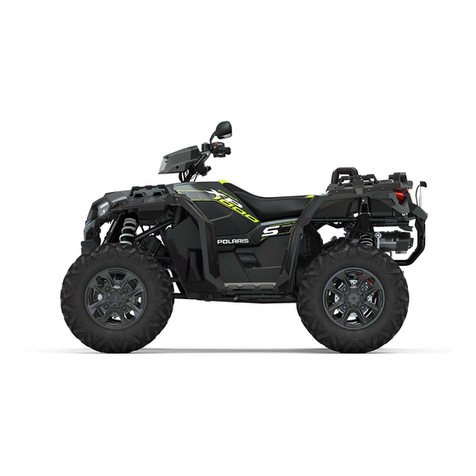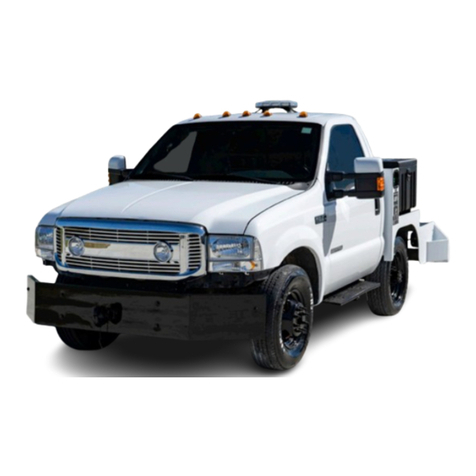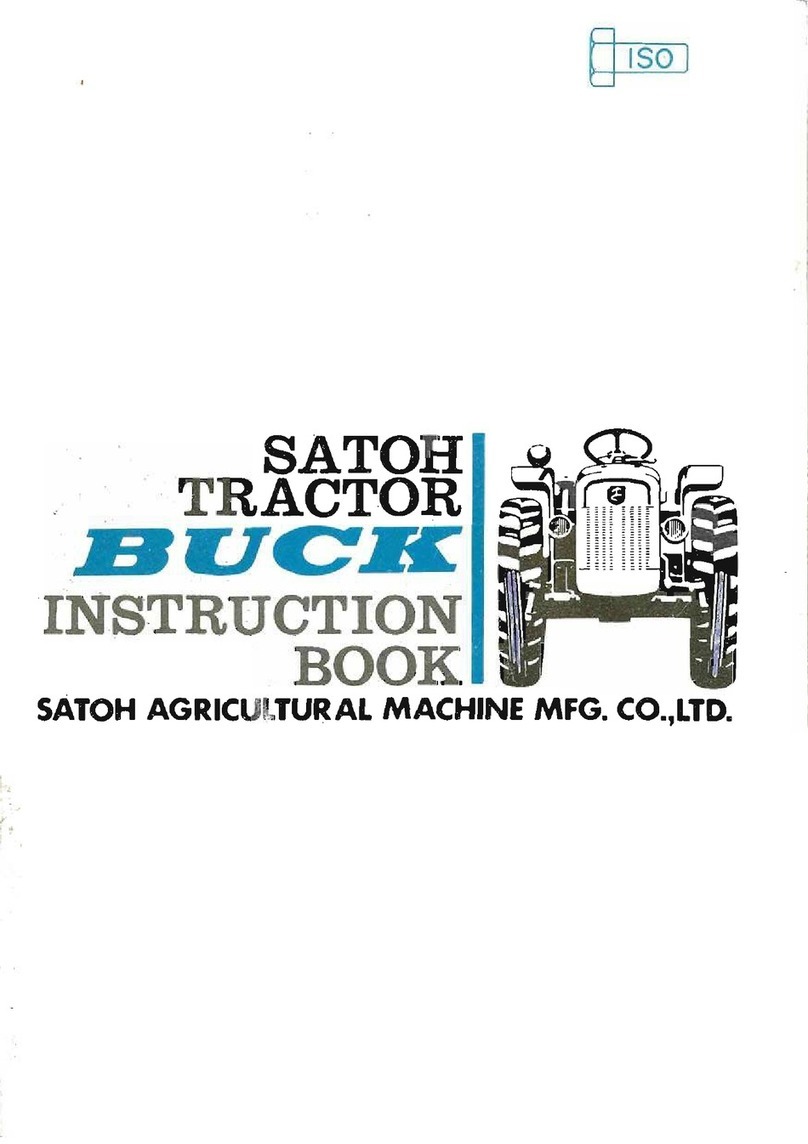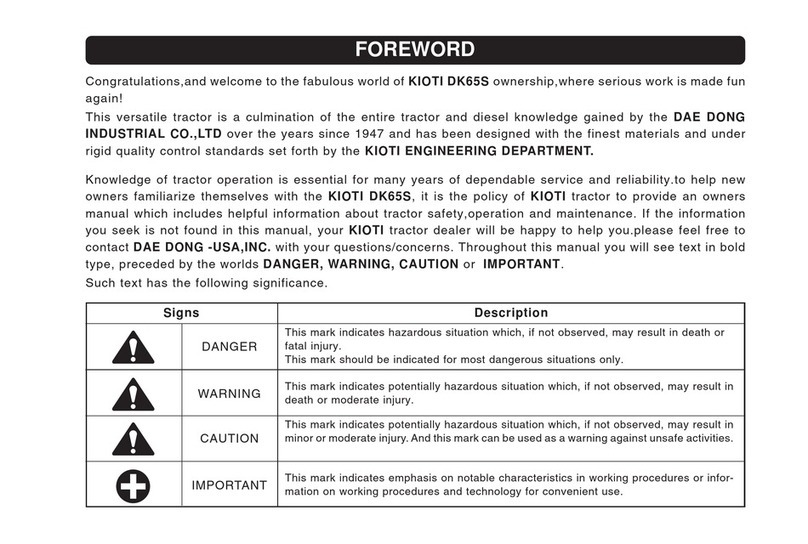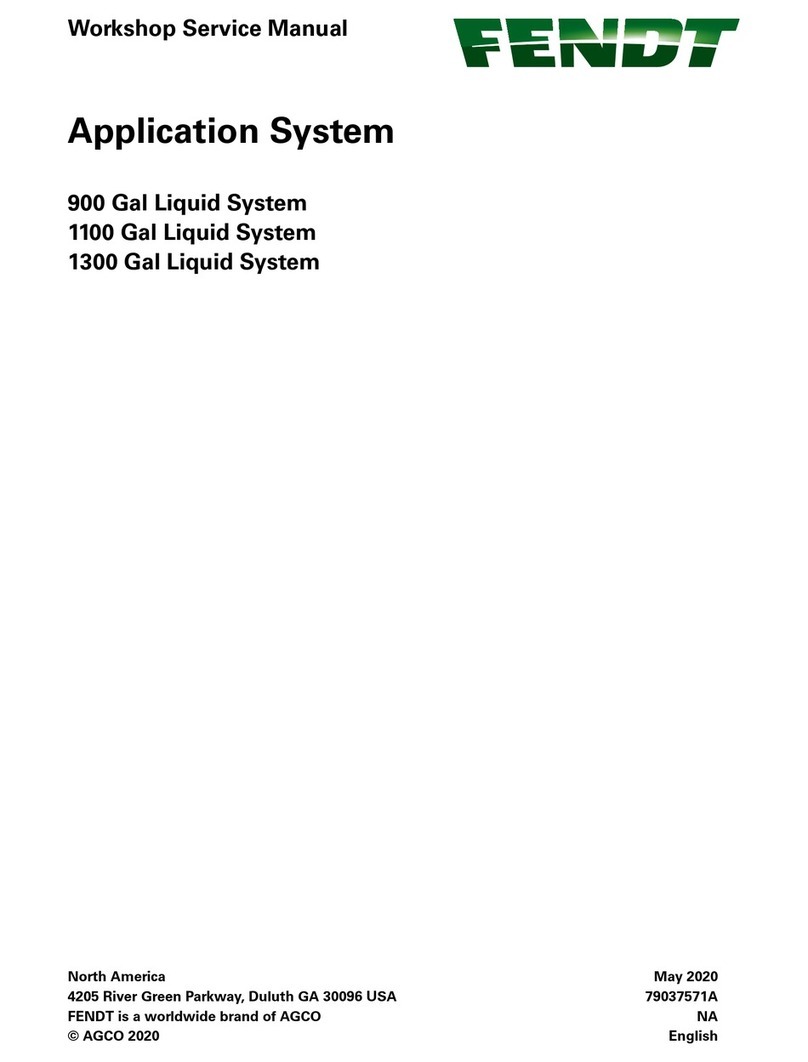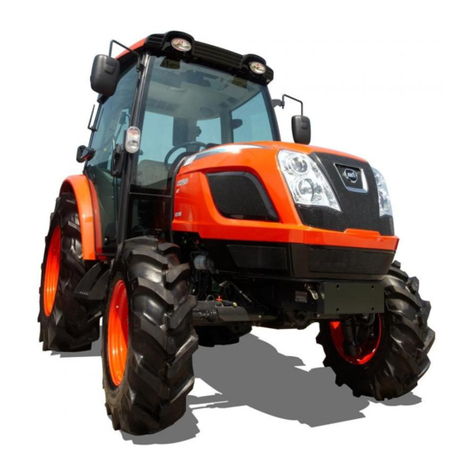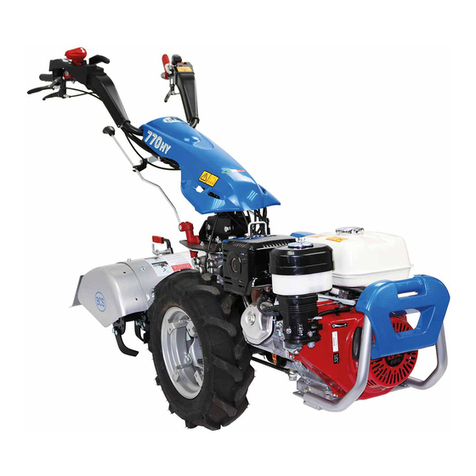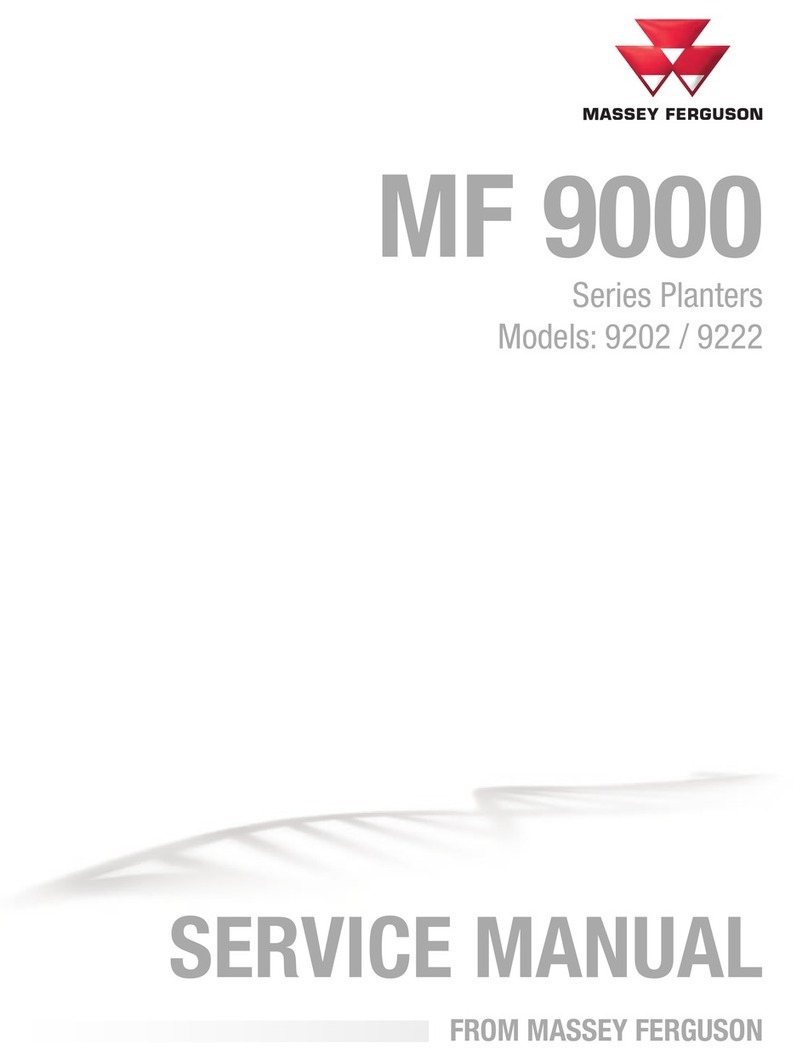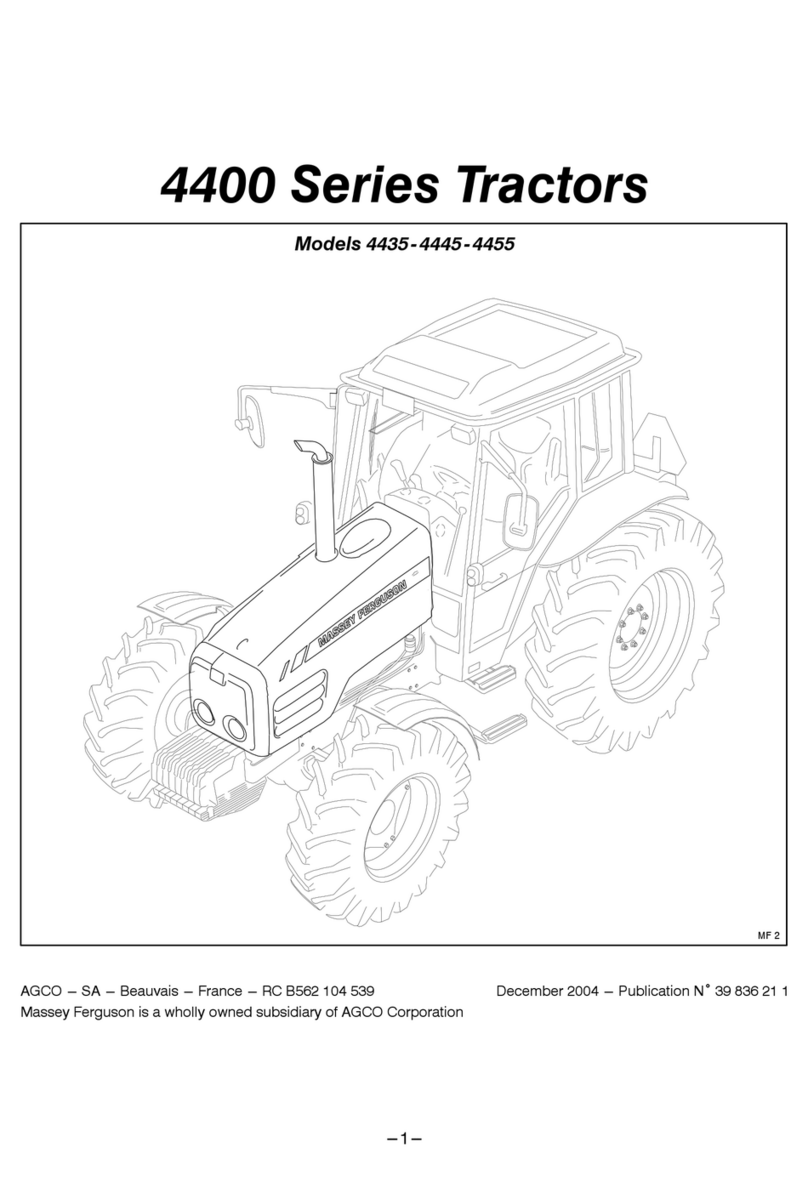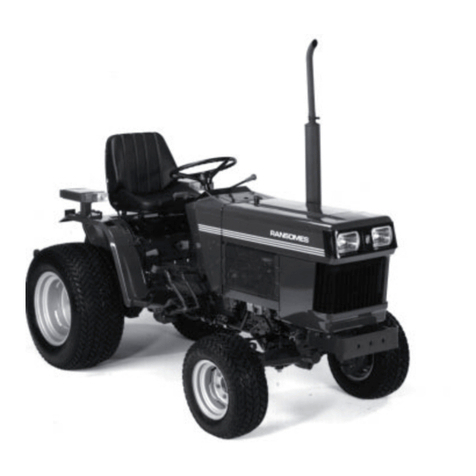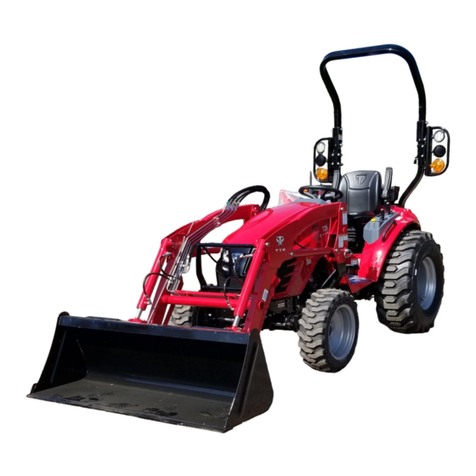TCP Hi-T500 Instruction manual

Compact Tracked
Carrier Mk 5 vl
Workshop Manual
TCP2473 Iss B Feb 2008
DCA 00257
Taylor Construction Plant Ltd.
Quayside Industrial Park, Bates Road,
Maldon, Essex, CM9 5FA
Tel:+44 (0)1621 850777
Fax:+44 (0)1621 843330
mailtcp.eu.com
www.tcp.eu.com
PDF compression, OCR, web optimization using a watermarked evaluation copy of CVISION PDFCompressor

Contents
Contents3.4 Maintenance Intervals 21
Preliminary 53.5 Service Access 22
Foreword 53.6 Lubrication 22
Warranty 53.7 General Inspection 23
Registration 53.8 Daily Check 23
Liability 53.9 Engine Oil Check 24
Audits and Surveys 53.10 Engine Oil Change 24
Service and Warranty Training 53.11 Air Filter 24
Warranty Terms 53.12 Fuel Filters 25
General Exclusions: 53.12.1 Tank Inlet Filter 25
Warranty Claim Submission Procedures 63.12.2 Tank Bottom Filter 25
Certificate of Conformity 63.12.3 Extra Filter 26
Kubota Engine Dealers 63.13 Hydraulic Filter/Oil 27
Service Bulletins 63.14 Charging the Battery 28
Machine Identification 63.15 Changing Track Motor Oil 28
Theft Deterrence 6
Recovery of a Stolen Machine 7Section 4 Fault Finding 29
Safety 74.1 Starting 29
General 74.1.1 Engine will not crank properly 29
Fire Precautions 84.1.2 Engine cranks but will not fire 29
Flammable Fluid Precautions 84.2 Battery Charging Check 30
Electrical Hazard 84.3 Tracking Speed 30
Pre-Starting
Starting 88Section 5 Parts Replacement 31
Operating 95.1 Recommended Tools 31
Lubrication and Servicing 95.2 Housing Removal 31
Specifications 95.3 Air Filter 31
5.4 Exhaust System 32
Section 1 Description 11 5.5 Ram 32
1.1 Introduction 11 5.6 Hydraulics Purging 33
1.2 Electrics 11 5.7 Valve Block 33
1.2.1 Ignition 11 5.8 Track Drive Motor 34
1.2.2 Charging Circuit 12 5.9 Battery 34
1.2.3 Tracking Speed 12 5.10 Oil Cooler Fan 35
1.2.4 Sounder Control 12 5.11 Engine and Pump Replacement 35
1.2.5 Oil Cooler Fan 12 5.12 Engine Removal 36
1.2.6 Oil Pressure Light 12 5.13 Engine Preparation 38
1.2.7 Hours Counter 12 5.13.1 Drive Shaft Preparation 38
1.3 Hydraulics 13 5.13.2 Regulator 38
Section 2 Operation 15 5.13.3 Fuel Vent
5.13.4 Plastic Filler Cap Replacement 3939
2.1 Controls 15 5.13.5 Engine Oil 40
2.1.8 Throttle 15 5.13.6 Hydraulic Pump and Power Take-off40
2.1.9 Steering 15 5.13.7 Engine Cable Loom 41
2.2 Daily Pre-start Inspection 15 5.14 Hydraulic Pump 42
2.3 Engine Operation 16 5.15 Track 43
2.4 Starting the Engine 16
2.5 Starting the Engine with Jumper Cables 16 Section 6 Hydraulic Pressure
2.6 Battery Charging 17 Adjustments 47
2.7 Moving and Stopping 17 6.1 Introduction 47
2.8 Stopping the Engine 17 6.2 Fitting Test Gauge 47
2.9 Parking 17 6.3 Service Line Relief Valve Adjustment 48
2.10 Loading 17 6.4 Ram Pressure Levels 49
2.11 Tipping 18 6.5 Track Drive Pressures 50
2.12 Average Specific Gravity 19 6.6 Completion 51
Section 3 Maintenance 21 Section 7 Drawings 53
3.1 General 21 7.1 Tracked Carrier Assy 2350 GA 53
3.2 Engine Maintenance 21 7.2 Chassis Assy Stage 1 SA-2351-01 54
3.3 Safety Precautions 21 7.3 Chassis Assy Stage 2 SA-2351-02 55
TCP-2473 Iss.B DCA 00257 3
PDF compression, OCR, web optimization using a watermarked evaluation copy of CVISION PDFCompressor

Contents
7.4 Chassis Assy Stage 3 SA-2351-03 56 7.19 Battery Leads.2357 72
7.5 Chassis Assy Stage 4 SA-2351-04 57 7.20 Jump Lead Link 1607 73
7.6 Chassis Assy Stage 5 SA-2351-05 58 7.21 Carrier Hydraulics 2352 74
7.7 Engine Enclosure Assy SA-1471 59 7.22 Hydraulic Hose Assy SA-2353 75
7.8 Labels (Decals) SA-1467 60 7.23 Hydraulic Tank Assy SA-1388 77
7.9 Battery Box Assy SA-2356 61 7.24 Control Valve SA-1598 78
7.10 Engine Assy & Dressing Kit SA-1928-01 62 7.25 Sound Kit Seq. Assy Chassis 1591 SA 79
7.11 Engine Service Kit SA-1928-02 63 7.26 Sound Kit Seq. Assy 1592 SA 80
7.12 Cooler Assy, Hydraulic SA-1470 64
7.13 Cold Start Assy Kubota Filter SA-1925 65 Appendix A Nut & Bolt Torque
7.14 Electrical Schematic 0C95 2355 66 Specification 81
7.15 Loom for Kubota 0C95 1574-01 67 1. Specific Torque Settings 81
7.16 Two Speed Loom WL-1574-02 69 2. Generic Torque Settings 81
7.17 Wiring For Auxiliaries WL-1574-03 70
7.18 Loom for Cold Start WL-1574-04 71
4TCP-2473 Iss.B DCA 00257
PDF compression, OCR, web optimization using a watermarked evaluation copy of CVISION PDFCompressor

Preliminary
Preliminary
Foreword
Thank you very much for purchasing this product.
We believe that it will serve you without fail. Ensure
that you read the operating instructions carefully
before use. With proper handling and maintenance,
this product will provide reliable, long-term service.
This manual is intended to serve as a manual for
workshop engineers. It assumes an engineering
knowledge commensurate with tasks that will be
undertaken in a workshop. For completeness, the
manual incorporates operating instructions
necessary to familiarise the operator and service
engineer with the controls, recommended
inspections, start-up, operating, and shutdown
procedures for HiT range of equipment.
Please read the operating instructions carefully and
understand them before operating the equipment.
Warranty
Registration
Each machine supplied by Taylor Construction
Plant (TCP) Ltd is accompanied by a registration
card. This card must be completed in full and
returned to:
Taylor Construction Plant Ltd.
Quayside Industrial Park
Bates Road
Maldon
Essex, CM9 5FA UK
Failure to register your machine may invalidate the
manufacturer's warranty.
Liability
The warranty period begins when the product is
delivered to and installed at the first purchaser.
Only genuine parts may be used to carry out
repairs. Failure to use only genuine parts may
invalidate the manufacturers warranty.
TCP Ltd will not be held responsible if:
the machine has been used to perform tasks that
demand more than it's design and strength
limitations, or
the machine has undergone modifications not
approved by TCP Ltd, or
conditions of use have been abnormal, or
TCP-2473 Iss.B DCA 00257
normal maintenance, with regard to
requirements as set out and detailed by the
manufacturer, have not been adhered to.
TCP Ltd will not pay for normal maintenance or
servicing nor any materials used to carry out routine
servicing.
The warranty liability of TCP Ltd is limited to
diagnosis, repair or replacement of the defective
part, and actuating the repair - depending on the
product terms and conditions, this will be free of
charge.
TCP Ltd shall be under no liability whatever to the
customer for any indirect loss and/or expense
(including loss of profit) suffered by the customer
arising out of a breach by TCP Ltd of this contract.
Audits and Surveys
TCP Ltd reserves the right to carry out audits and
inspections from time to time in relation to any
reimbursed or outstanding warranty claims in order
to determine that all relevant details and information
is correct.
Service and Warranty Training
Service and warranty training for service fitters can
be requested in writing. Initial training is to be
carried out at an appropriate TCP Ltd workshop.
Once this initial training has been carried out, you
are responsible for any further training required by
your own service centre or depot network.
Warranty Terms
One year or 1000 hours whichever occurs first from
date of installation
All engine warranty issues must be directed to the
engine manufacturer, or the manufacturer's
approved/appointed engine dealer.
General Exclusions:
THE FOLLOWING ARE WARRANTY
EXCLUSIONS AS DETERMINED BY KUBOTA:
Service items including lubricants, coolants, filters,
glow plugs, fan belts, fuel injection equipment, stop
solenoid/relay, charge regulator, leaks (oil, water
and air).
IN ADDITION: paintwork, wear parts and tracks.
5
PDF compression, OCR, web optimization using a watermarked evaluation copy of CVISION PDFCompressor

Prelliminary
Warranty Claim Submission Procedures
Claims must be reported accurately and all relevant
details given, as follows:
OWNERS NAME AND ADDRESS: full name and address
of customer and site location, if different
MACHINE TYPE: State machine type, i.e. Hi-T500,
tracked dumper, Hi-C40, crusher
Date of Failure:
SERIAL NUMBER: Serial number of unit
ENGINE NUMBER: Serial number of engine
HOURS USED: State hours used on hour clock.
Please do not guess the hours used
DETAILS OF FAILURE: Give a full report on the failure
ORDER NUMBER: An order number will be required
Note that the order number is to cover the
diagnostic and call out time, as well as to determine
the following:
That the failure is to be covered under the terms
and conditions of warranty. If this is the case,
then the costs will be covered by TCP Ltd and
the order number will not be used.
If the failure is determined to be of a non-
warrantable nature, further authorisation to
continue will be sought before any rectification
work takes place.
The information above must be provided even if
your warranty claim is a "parts only" claim. An
invoice will be raised for the exchange parts. The
reported faulty/defective part must immediately be
returned to TCP Ltd and full inspection of the parts
carried out, if the failure is covered under the terms
and conditions of warranty a credit note
corresponding to the invoice will be despatched to
the customer. If the failure is deemed to be of a
non-warrantable nature, the invoice should be
settled immediately.
Certificate of Conformity
This is a sample Certificate Of Conformity inserted
in this manual for reference, each machine is issued
with a bespoke certificate sent to the head office of
the purchaser and copies are available on the
request of purchaser.
Kubota Engine Dealers
To locate your nearest Kubota dealer, access the
Kubota web site at http://www.kubota.co.uk/ (for the
UK) or http://www.kubotaenqine.com/
kubotaworldwide.htm (for elsewhere).
6
Service Bulletins
TCPLtd may from time to time issue service
bulletins to keep you up to date as to any
improvements or changes that may take place on
the complete assembly or component parts.
Machine Identification
This manual may refer to controls and equipment
that are not present on your particular machine. It is
important that you know your machine and its
equipment and how to operate it properly.
Information regarding the machine model, code and
chassis serial number is on the unit serial number
plate (Fig 1). This plate is on the rear left-hand side.
Always quote the machine model and serial number
in correspondence with your dealer or the factory.
CERTIFICATE OF CONFORMITY
We declare that this product complies with the
following Standards/Directives.
-Machinery Directive 89/392/EEC as
implemented by The Supply of Machinery
(Safety) Regulations 1992 (Amended 1994).
-BS/EN500 Mobile road construction
machinery (Safety)
Product :Tracked Carrier
Model :HIT 500
Serial No :HT-Bxxxx
Manufacturer Date :xx/xx/2006
Signed:
Date: xx/xx/2006
Mr Paul Drew
Development Manager
Tel: +44 (0)1621 85[1777
Fax': +44 (0)1E21 843330
vrvyvy.tv.eu.com
MODEL NO:
SERIAL NO:
ENGINE TYPE:
ENGINE SERIAL NO:
CE YEAR OF MANUFACTURE'
Fig 1 Data plate
Theft Deterrence
The owner/operator should take the following
precautions to discourage theft, to aid in recovery in
the event that the machine is stolen, or to reduce
vandalism.
TCP-2473 Iss.B DCA 00257
PDF compression, OCR, web optimization using a watermarked evaluation copy of CVISION PDFCompressor

Remove all keys any time the machine is left
unattended.
Immobilise the machine by removing a critical
electrical or starting system device.
Upon receipt of a machine, record the machine
serial number and the serial numbers of all-
major components and attachments. Keep this
list up to date and filed in a safe location for fast
retrieval.
Place a decal or notice on the machine stating
that all serial numbers are recorded.
Discourage the thief! Inspect the gates and
fences of the machinery storage yard or
construction site. Keep machines in well-lit
areas and ask the local law enforcement
authorities to make frequent checks around the
storage yard or work site.
Liaise with neighbours. Ask them to watch
equipment left at job sites and to report any
suspicious activities to local allow enforcement
authorities.
Make frequent inventories of machines to
promptly detect losses or vandalism.
Recovery of a Stolen Machine
In the event of theft, immediately notify the law
enforcement authorities having jurisdiction. Provide
the investigating officer with name, type of
equipment, chassis and serial numbers of major
attachments and components. It would be helpful to
show the investigating officer an Operator's
Handbook, photographs, and advertising, to
familiarise him with the appearance of the machine.
Report the theft to the insurance company. Provide
the model and all serial numbers.
Report the model and serial numbers of the stolen
machine to a dealer handling the respective line of
equipment. Request that the dealer forward this
same information to the equipment manufacturer.
Safety
This piece of equipment is designed as a compact
tracked carrier with the carrying capacity of 500 Kg
only.Always carry loads with the body in the low position
and only raise it for tipping when the unit is
stationery
FAILURE TO COMPLY WITH WARNINGS COULD
RESULT IN SERIOUS PROPERTY DAMAGE AND
POSSIBLE PERSONAL INJURY.
The machine should be properly operated and
maintained to keep it in safe efficient operating
condition. Be sure that all controls are free of mud,
TCP-2473 Iss.B DCA 00257
Preliminary
grease, or other matter that might cause slips
hazardous to the operator, service engineer, or
other personnel or equipment.
Report all malfunctions to those responsible for
maintenance. Do not operate the equipment until
corrected. Normal service or maintenance
performed as required can prevent unexpected and
unnecessary down time. This handbook describes
general inspections, servicing and operation with
the normal safety precautions required for normal
servicing and operating conditions. It is not a guide
however, for other than normal conditions or
situations.
Operators and service engineers must be safety
conscious and alert to recognise potential operating
or servicing safety hazards at all times, and take,
necessary precautions to ensure safe operation and
servicing of the machine.
All information, illustrations and specifications
contained in this publication are based on the latest
product information available at the time of
publication. The right is reserved to make changes
at any time without notice
Continuing improvement and advancement of the
design may cause changes to your machine that
may not be included in this publication.
This Handbook contains lubrication and routine
servicing instructions, most of which can be
performed in the field.
General
A WARNING
Read this operator's Handbook and learn the
operating characteristics and limitations of the
machine. Know what operating clearances the
machine requires.
Know clearances of all side and overhead
obstructions such as wires, etc., for operating
safety.
Be aware of operating hazards that weather
changes can create on the job. Know proper
procedures to follow when a severe rain or
electrical storm strikes.
Never attempt to operate or work on a machine
when not feeling physically fit.
Know what safety equipment is required and use
it. Such equipment may be hardhat, safety
glasses, reflector type vests, respirators and
earplugs.
Never wear loose clothing, rings, and watches
etc. that might catch levers and controls and
cause loss of control.
7
PDF compression, OCR, web optimization using a watermarked evaluation copy of CVISION PDFCompressor

Prelliminary
Keep hand controls free from water, grease and
mud to assure non-slip control.
Handle fuels and lubricants carefully and clean
up spills to avoid fire and slipping hazards.
Never rush. Walk do not run.
Fire Precautions
A WARNING
Clean all dirt, oil, grease and other fluids from
systems and components to minimise fire
hazards and aid in spotting loose or leaking
lines, fittings etc.
Check the engine for rubbish, oily rags or other
debris that could cause fires before starting the
engine.
Safely dispose of greasy, oily rags or similar
hazards.
Flammable Fluid Precautions
A WARNING
Take due care when working with fuel. Diesel
fuel is a health hazard for contact with eyes or
sin, inhalation and ingestion. There is also
danger of fire and pollution.
Don't use diesel fuel or other flammable fluids for
cleaning purposes. Use approved non-
flammable solvents.
Make sure all-fluid systems caps, drain, valves,
fittings, lines etc., are secure and leak free.
Never use an open flame (match, lighter etc.)
when checking fuel, lubricant, coolant and
battery fluid levels or when checking for fluid
leaks. Use a flashlight or other safe lighting only.
Shut off engine and use extra caution if engine is
hot when refuelling.
Never smoke while checking or adding fuel or
other fluid or handling fluid containers and lines.
Use care and do not stand downwind when
adding fuel or other flammable fluids to tanks
and reservoirs to avoid fluids being blown or
splashed onto clothing.
Close fuel tank shut-off valves, if used, before
servicing fuel system.
When preparing machines or components for
storage, seal and tape all openings and close
containers tightly to seal in all volatile inhibitor
fluids and compounds used.
Follow manufacturer's recommendations when
handling and using engine-starting fluids and
disposing of spent containers. Do not puncture
8
or burn empty containers. These fluids are
explosive and highly flammable.
Electrical Hazard.
A. WARNING
Never smoke or allow open flames or sparks
near batteries.
Always disconnect batteries before repairing
electrical system to avoid danger of fire-causing
sparks. Disconnect battery ground cable first and
reconnect last.
Always disconnect batteries and alternator leads
before carrying out any welding on the machine.
Never check battery charge by placing metal
objects across battery posts to avoid sparks at
battery posts.
Use jumper cables only as recommended.
Improper use can result in battery explosion or
unexpected machine motion.
Never operate engine starter for more than 15
seconds and allow 30 seconds between
cranking periods for cooling. An overheated
starter could cause a fire.
Pre-Starting
A WARNING
If engine is to be started and run indoors, ensure
proper ventilation to remove deadly exhaust
gases.
Always perform 'Pre-Starting Inspection'
instructions described in this manual to ensure
the machine is ready for operation.
Starting
A WARNING
Do not start the engine or operate any control if
there is a 'DO NOT OPERATE' or similar
warning sign attached to any control.
Use jumper cables only as recommended.
Improper use can result in battery explosion or
unexpected machine motion.
Always obey 'Starting the Engine' instructions.
Start and operate the machine only from the
operator's station.
TCP-2473 Iss.B DCA 00257
PDF compression, OCR, web optimization using a watermarked evaluation copy of CVISION PDFCompressor

Operating Specifications
A WARNING
Always perform 'Pre-Operating Checks'
described in this manual to ensure the machine
is ready for operating.
Do not operate the machine if exposed
personnel enter the immediate work area.
Be sure the body is fully down before moving the
machine-warning buzzer will sound if body is not
fully down.
Always try to face or look in the direction the
machine is travelling.
Always operate straight up or down slopes
whenever possible. Side-hill operation can cause
sideslip and possible rollover.
Slow down when moving in congested areas. Do
not race with other machines. Stop in authorised
areas only, except in an emergency.
Always watch for holes, soft edges or other
hazards when dumping over a spoil bank.
Operate body raising mechanism on firm level
surface only, a buzzer will sound to warn the
operator and others in the area once the body
raises above horizontal.
Lubrication and Servicing
A WARNING
Do not allow unauthorised personnel to service
or maintain the machine. Study the Operator's
handbook and Service Manual before starting,
operating or servicing the machine.
Do not work under or near unblocked or
unsupported body. Always invert the empty
body.
Do not work under or near any unblocked or
unsupported linkage, part or machine.
Always relieve pressure before servicing any
pressurised system.
Preliminary
Maximum carrying capacity 500 kg
(1100 lb)
Skip volume 255 It
(9.0 ft 3)
Unladen weight (9448kg87 lb)
Width 700 mm
(28 in)
Height 1165 mm
(45.8 in)
Height over skip 2500 mm
(98.4 in)
Height under skip 1200 mm
(47 in)
Length 1770 mm
(69.6 in)
Max grade ability 45%
Turning circle 2000 mm
(78.5 in)
Track ground pressure 0.351 g/cm2
(4.99 i)p s
Engine (with electric start)
Kubota 0C95 7.1 kW
(9.5 hp)
Speed forward 4 kph max.
(2.5 mph)
Speed reverse 2 kph
(1.2 mph)
Power take off - optional 20 It/m @
120 bar
Noise level 99 dBa
TCP-2473 Iss.B DCA 00257 9
PDF compression, OCR, web optimization using a watermarked evaluation copy of CVISION PDFCompressor

Section 1 Description
1.1 Introduction
Section 1 Description
1.1 Introduction
The HiT500 is a Compact Tracked Carrier designed
for general use on building sites. Its small size and
manoeuvrability make it ideal for operation in
confined spaces. The rubber tracks give it traction
on most kinds of terrain.
A diesel engine drives a hydraulic pump to provide
motive power for track motion and skip movement.
The pump is coupled directly to the crankshaft at
the front of the engine. A hydraulic tank fitted in
front of the pump under the skip provides a
reservoir of oil for the pump.
Drive to the tracks is by two hydraulic motors at the
rear of the track. The motors are individually
powered to provide steering.
Skip movement is effected by hydraulic rams - one
pair for tipping and one for raising the skip. A
warning siren sounds while the skip is raised.
Levers on the control panel route hydraulic oil at
pressure to the rams and drive motors to control
operations. A Tracking Speed button opens a valve
to provide additional hydraulic flow to the motors to
increase tracking speed.
A hand throttle provides control of engine power to
tailor engine output to the task in hand.
1+-T--T- 12Vbattery
-T--T-
FS1
30A fuse
1.2 Electrics
The diagrams in this section are for explanatory
purposes only. Refer to drawing TCP-1574 in
Section 7.14 Electrical Schematic 0C95 for full
information.
1.2.1 Ignition
The ignition circuit features automatic starting, using
a 5s timer and relay to power the glow plug. When
the ignition switch is set to Start, the contacts of the
5s timer are initially closed so that relay RLA is
energized and contact RLA1 connects 12V to the
glow plug. After a 5s delay, the timer contacts open
and de-energize relay RLA. Contact RLA1 changes
over to disconnect the glow plug and connect the
starter motor solenoid instead. Once the engine
has started, releasing the ignition switch
disconnects the starter motor solenoid. The
solenoid connects to the negative side of the battery
through the chassis.
The Thermal cutout provides a warm-start option. If
the ambient temperature in the engine compartment
is greater than 20°C, the thermal cutout will be open
circuit. Hence relay RLA will not then operate. As a
result, the glow plug will not operate and the starter
Ignition switch
Starter
motor
0
<1
Solenoid
OffAC
0PF
Start
0
Accessory 12V
19Preheat
RLA1
Glowplug
Relay
RLA
Thermal
8 cutout
(optional)
Timerl5s
............ .......
Fig 1-1 Ignition circuit
TCP-2473 Iss.B DCA 00257 11
PDF compression, OCR, web optimization using a watermarked evaluation copy of CVISION PDFCompressor

Section 1 Description
1.2 Electrics
motor will start immediately the ignition switch is set
to Start. If this warm-start option is not required,
e.g. for a very cold climate, the cutout is linked out
so that the start delay is always used.
If the timer or relay should develop a fault, the
engine can still be started in the usual manner for a
diesel engine. Setting the ignition switch to PH
(Preheat) for 5s will power the glow plug. Moving
the switch on to Start will operate the starter motor.
This can be done even if the timer is not fitted or if
relay RLA will not energize.
1.2.2 Charging Circuit
Accessory +12V
Generator Regulator
30Afuse
FS1
12V
battery -7--7-
Fig 1-2 Charging circuit
The regulator converts the a.c. output from the
generator to d.c. and regulates the charging current
it supplies to the battery to maintain a full charge.
1.2.3 Tracking Speed
Accessory 12V
15A fuse
FS2
LH track
drive
Tracking
speed
button
12
Micro-
switches
RH track
drive
RLB2
Hydraulic Motor speed
pressure selection
selection
Fig 1-3 Tracking speed
The Tracking Speed button opens hydraulic valve
V1 to supply extra power to the track motors. A
second valve V4 sets the motors to run at a higher
speed. When a drive lever is set to forward or
reverse, one of the microswitches is operated. If
the tracking speed button is then pressed, the
circuit is completed to energize relay RLB. Contact
RLB1 holds the relay on when the button is
released. Contact RLB2 energizes the high-speed
valves.
1.2.4 Sounder Control
Accessory 12V
15A fuse
FS2
Proximity
sensor L _ _
RLC1
Relay
Sounder
Fig 1-4 Sounder control
A sounder operates while the arm has moved to
raise the bucket. A sensor fitted in the frame
senses the presence of the arm. When the arm
moves away, the sensor contacts close and
energize relay RLC. Contact RLC1 activates the
sounder.
1.2.5 Oil Cooler Fan
The oil cooler fan is powered from the 12V
Accessory supply via a diode. The diode prevents
back-emf generated by the fan motor from reaching
other circuits when the machine is powered down.
1.2.6 Oil Pressure Light
An oil pressure switch turns on the oil pressure
warning light if the oil pressure is low.
1.2.7 Hours Counter
The hours counter, powered from the 12V
Accessory supply, via the 15A fuse, measures the
elapsed time while the machine is operating.
TCP-2473 Iss.B DCA 00257
PDF compression, OCR, web optimization using a watermarked evaluation copy of CVISION PDFCompressor

1.3 Hydraulics
Refer to the Hydraulic Schematic drawing in Section
7.21 Carrier Hydraulics .
The diesel engine drives a hydraulic pump coupled
to its shaft. This pump provides two outputs:
a 3 cc per rev, low flow, high pressure output for
low speed and general use and
an 8 cc boost output.
These are combined to provide an 11 cc/rev high
flow, high pressure boost drive for the high speed
track drive.
In the idling condition, the hydraulic fluid circulates
around the system at low pressure.
When a Tipping control valve is operated, it directs
the fluid to operate the appropriate rams to move
the bucket. The valve controls the direction of fluid
flow to the rams and hence controls the direction of
movement. Pressure relief valves mounted on the
rams control the fluid pressure applied to each ram.
When a Drive control valve is operated, it directs
the fluid in the appropriate direction to hydraulic
motors on the track sprocket drive shafts. Any
leakage within the motor returns to the sump
through a return hose..
Normal supply To drive
control valves
Solenoid
valve
V1
V2Tracking
Tracking speed valve
speed
supplyFig 1-5 Tracking speed hydraulics
Return
to tank
TCP-2473 Iss.B DCA 00257
Section 1 Description
1.3 Hydraulics
The Tracking Speed button provides increased
drive speed. If the button is pressed while either of
the Drive levers is pushed fully forwards or
backwards, solenoid-controlled valve V1 (Fig 1-5)
feeds pressure to operate the tracking speed valve
V2 which routes the boosted pressure from the
pump to the drive control valves and hence to the
motors. Pressure relief valve V3 regulates the
pressure on the line.
The track drive motors employ swash plates.
Varying the angle of these plates varies the drive
supplied to the shafts. Each motor contains a valve
which, when activated, causes the swash plate to
be tilted so that extra drive is applied to the shaft,
giving increased tracking speed. Solenoid valve
V4, energised along with V1, activates the valves in
the motors (Fig 1-6).
Tracking
supply
V4
Return
to tank
Motor
drive
Return
to tank
Motor
drive
Return
to tank
Fig 1-6 Tracking motor speed control
Motor
high speed
selection
Motor
high speed
selection
13
PDF compression, OCR, web optimization using a watermarked evaluation copy of CVISION PDFCompressor

Section 2 Operation
Section 2 Operation
0DIESEL ONLY
LIFTING EYE
S.W.L 750 Kg
IMPORTANT: READ AND UNDERSTAND THE OPERATOR'S MANUAL BEFORE USE.
1}THIS WLCHIH C IS f RTEDW1111 A CODS TART LOFTON SY STER TURN KEY TO START POSITOI AHI HOLD.
ENGINE WI_ STA RTAJTONATICALLY W FINN la SECS. CEPEPEN NG CH ENGFE TEMPERATURE.
2)G RAJA __Y C A HOT ENGI PE BEFORE SWITCHHG IT OFF.
3)TH i WO R.< STATION HAS BEEN CIES OsED FOR S NOE CPERAT ICH.
1)A3-1CLI REVERS HG PAY CAREFUL ATTENTION TO CRUSH =MS PERSONNEL ARC OBSTRUCTION.
MAINTENANCE:
i) NEVER PE RFORIA .AFN IAANTENANCE WURK LI ND L HAN UNI 'HUFFED LIMY_
2) CLEAN ANY EIU ID LP OF MATER AL FROM PAOVING I AH 'NASH I F NECESSARY.
3) CHECK F LJEL ONLY (OILY ugE CLEAN FUEL.
A) CH ECK OIL (DALY.
5) GREASE DALY. MAXIMUM DESIGN PAYLOAD 0 F 600 kg 1,1AX: GRADE 45%
P.T.O. DRIVE TIPPING
FLOW
BY-PASS
FORWARD FORWARD
NEUTRAL NEUTRAL
:C3.
REVERSE REVERSE
'MAW. tC p.e u.corn
Tot-HA IC. 161-177
No .14 L °ilea 143110
.A.112.1t,Peu
LOWER
STOP
Q
RAISE
FORWARD
STOP
BACK
HAV VaIAL
[HACKING
SPEED
-C.EliC ACE H
HCii:" EL
ENLAC-111 CH .1FE 1.11:-1
0
2.1 Controls
2.1.8 Throttle
This is mounted on the left-hand side of handlebar
assembly and is operated by hand. Press the lever
down to increase fuel flow and accelerate the
engine.
Do not place engine under full load at full speed
immediately after starting. Always allow the engine
to circulate lubricant fully and warm up gradually
before operating at full speed and full load. A 20-
minute warm-up is recommended. Operate the
engine at top rated speed when maximum power is
needed for maximum speed or load.
2.1.9 Steering
A WARNING Take due care when driving
the machine.
Steering is achieved by driving one track harder
than the other.
To drive in a straight line, apply equal pressures to
both Drive levers.
To steer left, press the right-hand Drive lever
forwards harder than the other and conversely.
TCP-2473 Iss.B DCA 00257
To drive in reverse, put the levers in the Reverse
positions. The same principles of steering left or
right apply as driving forwards.
To turn the machine on the spot, drive one track
forwards and the other in reverse.
The machine will stop when both levers are
released (dead-man brake).
2.2 Daily Pre-start Inspection
These instructions must be carried out to assure
continuance of engine warranty.
Full routine maintenance procedures are given in
Section 3 Maintenance.
1. Ensure that the machine is ready for operation
before the starting it.
2. The machine should be in a level position to
permit accurate checking of fluid quantities in
the engine and other components.
3. Open the left hand side of the engine
enclosure to access to the engine for routine
maintenance.
Note: Refer to the engine manufacture's
handbook for engine maintenance details.
4. Engine - With engine off, check oil level. The
oil should be just over the top thread at filler
Add oil if low. (See Table 3-2 for correct oil).
15
PDF compression, OCR, web optimization using a watermarked evaluation copy of CVISION PDFCompressor

Section 2 Operation
2.3 Engine Operation
5. Inspect the engine air cleaner for any damage.
(If damaged, replace it immediately. Using an
engine with a damaged air cleaner will
seriously reduce engine life).
6. Check that oil cooler outlet grill (between body
and chassis) is clear of obstructions.
7. Carefully inspect tracks for cuts or other
damage and for correct spring preload.
8. Inspect for any leaks whether fuel, engine oil or
hydraulic oil.
9. Check fuel level.
To prevent condensation from contaminating the
fuel, fill the fuel tank at end of each shift.
2.3 Engine Operation
Do not place engine under full load or full speed
immediately after starting. ALWAYS allow the
engine to fully circulate lubricant and warm up
gradually before operating at full speed and full
load.
Operate engine at top rated speed when maximum
power is needed for the load.
Do not idle the engine for more than five minutes at
a time. Shut it off.
If engine operates outside its normal operating
range, shut it down immediately and report to
service or maintenance personnel.
A WARNING Never start the engine indoors
unless proper exhaust ventilation is provided to
remove deadly exhaust gases. Once the engine is
running, move the machine outdoors as soon as
possible. Exhaust gases are hazardous and can
cause unconsciousness and death.
Operating the engine beyond high idle speed can
cause severe engine damage. The engine speed
must not exceed 3,600 rev/min under any
circumstances. When descending a steep grade,
use a combination of lever and engine speed.
2.4 Starting the Engine
The MK4 is fitted with delay circuit to allow the glow
plug to reach its operating temperature before the
engine cranks. This delay circuit operates only if
the ambient temperature is below 20 degrees.
1. Make sure that all levers are in the neutral
position.
2. Insert switch key and turn fully clockwise to
position '3' and hold. The engine will crank
automatically after approximately 5 seconds.
3. Release key when engine starts.
16
Never crank the engine for more than 10 seconds
continuously.
To avoid overheating, allow starter at least 30
seconds cooling time between cranking periods.
2.5 Starting the Engine with
Jumper Cables.
Access to the battery and starter motor terminals is
restricted on the Mk4. To allow jump starting to take
place a Stud Terminal is located on the left rear of
the engine mounting frame, this Stud Terminal is
connected to the positive stud on the battery.
To access this Stud Terminal open the left hand
side of the engine enclosure.
Charging of Odyssey Batteries
Check polarity of discharged battery connections.
Do not allow charging voltage to exceed 15 volts.
Excessive booster voltage and/or incorrect jumper
cable connections will destroy plates inside battery.
Keep all sources of ignition away from batteries. Do
not lean over batteries.
Do not allow the battery to become fully discharged.
The battery may no be able to recover from this
state, rendering it unserviceable.
Voltmeter
Reading State of
charge
12.84 Volts 100%
12.50 Volts 75%
12.18 Volts 50%
11.88 Volts 25%
Do not jump start a vehicle by using arc welding
equipment. Currents and voltages are dangerously
high and cannot be sufficiently reduced to make the
method safe.
Be sure machines are not touching each other.
Use cables that are the same size as those on the
machine.
If jumper cables are used to start an engine, be
sure to follow this procedure:
1. Connect one end of the jumper cable, usually
coloured red, to the discharged battery
`POSITIVE' (+) stud terminal.
2. Connect the other end of the same cable to the
`POSITIVE' (+) post on the booster or charged
battery.
TCP-2473 Iss.B DCA 00257
PDF compression, OCR, web optimization using a watermarked evaluation copy of CVISION PDFCompressor

3. Connect one end of the second cable, usually
coloured black to the NEGATIVE' (-) post of
the booster battery.
4. Connect one end of the jumper cable to a
convenient point on the engine frame
`NEGATIVE' (-).
5. Keep grounding point clear of battery so that if
a spark occurs, it is away from battery fumes
(explosive hydrogen).
6. Locate cause of battery failure.
2.6 Battery Charging
If the battery is not being charged properly, refer to
Section 4.2 Battery Charging. The battery can be
charged from the mains as detailed in Section 3.14
Charging the Battery.
2.7 Moving and Stopping
A WARNING Make sure the area around the
machine is clear of personnel and obstructions
before moving off.
1. In the first few minutes of travel, try out the
controls to ensure you operate with maximum
safety.
2. Make sure the skip is fully down. The siren will
sound if in the raised position.
3. Select the driving direction and the required
engine speed.
4. Move levers to the required position; apply
more acceleration until the required speed has
been reached.
5. If running a good distance on a good surface,
press the Tracking Speed button to increase
the speed.
6. To stop the machine release the control levers
slowly and release the accelerator as the
machine slows until it stops.
2.8 Stopping the Engine
1. Cool a hot engine by operating the engine at
1,000 rev/min and then slowly decelerating it
over a 5-minute period until the engine is idling.
Let it idle for at least 2 minutes.
Always cool a hot engine gradually before shutting it
off.
2. Turn ignition key switch off to shut off fuel and
stop engine.
3. Make sure body is in the lower position.
TCP-2473 Iss.B DCA 00257
Section 2 Operation
2.6 Battery Charging
2.9 Parking
A WARNING When parking the machine
overnight or for an extended period, the following
procedure in addition to that given in Section 2.8
Stopping the Engine will help maintain it in good
condition:
1. To prevent condensation from contaminating
the fuel, fill the fuel tank completely before
parking the machine overnight or for extended
periods. If a security kit is supplied, keep it
locked
2. Park on level ground where possible. If it must
be parked on a slope, position machine at right
angles to the slope and block tracks securely.
3. Remove key to a place of safety
Check tracks, hoses, wiring, tubing and fittings for
cuts, abrasion, fraying, or other damage or
deterioration. Inspect for damage to the body or
chassis.
Attach warning signs to the controls to alert others if
lubricant has been drained, batteries removed etc.
2.10 Loading
The most common methods of loading this type of
machine are with hydraulic excavators and by hand.
These units can be loaded equally well from the
front or the side. Ideally, excavators should require
90° or less swing.
Always position the machine on a level firm surface
for loading and leave the loading area until
indicated by loader driver.
The following precautions should be observed when
approaching the loading area and while being
loaded wait until it is safe to return to the machine.
Avoid over-filling the skip. Spillage could damage
the tracks and other components. Clear up any
such debris.
Do not load with machines that are too large and
would allow material and fill to fall from the skip,
missing the body. This can be dangerous to both
operator and the unit.
Pay attention to site conditions: avoid rocks, holes,
or other obstacles. Such obstacles present hazards
to safe operation but also can needlessly damage
tracks.
17
PDF compression, OCR, web optimization using a watermarked evaluation copy of CVISION PDFCompressor

Section 2 Operation
2.11 Tipping
2.11 Tipping
The tipping operation usually depends on the type
of material being hauled.
rBe aware of other personnel
within the operating area.
A WARNING
A warning buzzer sounds whenever the skip is
raised above the horizontal position. This is a
general warning to the operators and other
personnel in the area to take necessary care and
precautions.
If tipping at low level, ensure you are clear of all
obstacles within the tipping arc of the skip. It is
possible to fully invert the body of the Hi-T tracked
carrier, care must be taken that the load to be
discharged will readily leave the body once tipping
commences. A retained load may result in machine
instability.
Never leave a machine loaded overnight or for a
long period with a material that could settle.
Always clean any retained load from the skip for
efficient, safe working.
18
Be aware of any precautions and additional safety
equipment that may be needed when handling,
hazardous, caustic or cement materials.
If in doubt seek advice.
On discharging the load, ensure that the machine is
on firm, level ground. If one track were to be higher
than the other, a twisting strain would be imposed
upon the body hinge pins and chassis. This could
result in machine instability and damage.
Use the control levers to position the body. Operate
from the designed operating position only. Keep
clear of the tipping mechanism or you could be
injured. Once the load has been tipped, move the
Tipping lever into the 'LOWER' position.
If the load does not clear completely, the built-in
stops in the mechanism may used to assist
discharge. The ram cylinder does not need to be
retracted before extending again.
To tip into a waste skip, choose a position that will
allow the body to fully discharge its load. Only raise
the skip with the machine stationary. Once the skip
is raised, the machine may be inched forward until
the tracks contact the side of the waste skip. The
skip can then be tipped to discharge load.
TCP-2473 Iss.B DCA 00257
PDF compression, OCR, web optimization using a watermarked evaluation copy of CVISION PDFCompressor

Section 2 Operation
2.12 Average Specific Gravity
2.12 Average Specific Gravity
Material Loose Density Fill
kg/m3 Ib /yd3 °A
Snow (Fresh) 200 337 100
Peat (Dry); 400 674 100
Sugar beet 530 894 100
Coke (Loose) 570 961 85
Barley 600 1012 85
Petroleum Coke 680 1146 85
Wheat 730 1231 85
Coal Bituminous 765 1290 100
Fertilizer (Mixed) 1030 1737 85
Coal Anthracite 1046 1764 100
Earth (Dry)(Loose) 1150 1939 100
Nitrate Fertilizer 1250 2180 85
Sodium Chloride (Dry)(Salt) 1300 2192 85
Cement Portland 1440 2428 100
Limestone (Crushed) 1530 2580 100
Sand (Dry) 1550 2613 100
Asphalt 1600 2698 100
Gravel (Dry) 1650 2782 85
Clay (Wet) 1680 2832 110
Sand (Wet) 1890 3187 110
Fire Clay 2080 3507 100
Ready Mixed Concrete 2194 3698 85
Copper (Concentrate) 2300 3878 85
Slate 2800 4721 100
Magnetite 3204 5402 100
TCP-2473 Iss.B DCA 00257 19
PDF compression, OCR, web optimization using a watermarked evaluation copy of CVISION PDFCompressor
Table of contents




